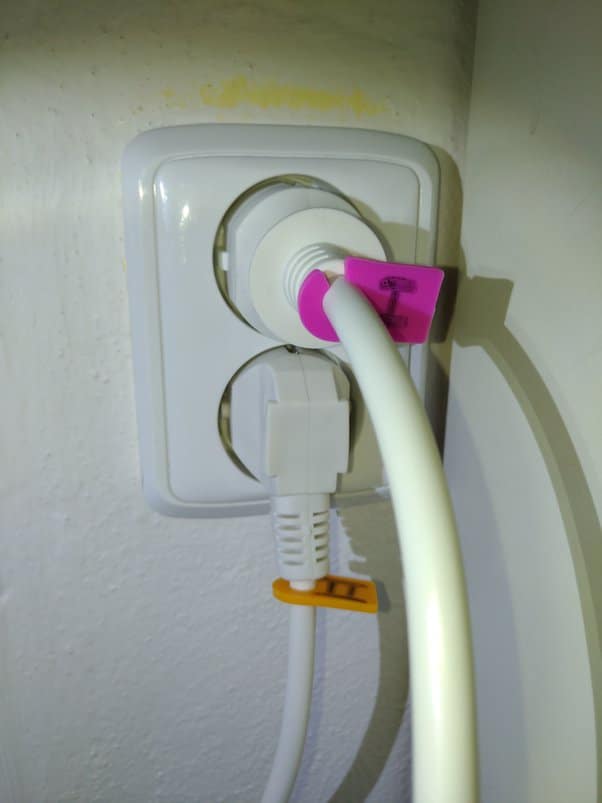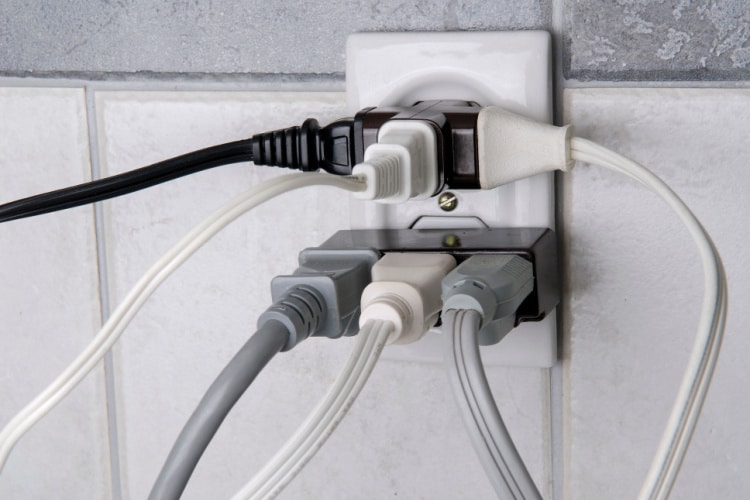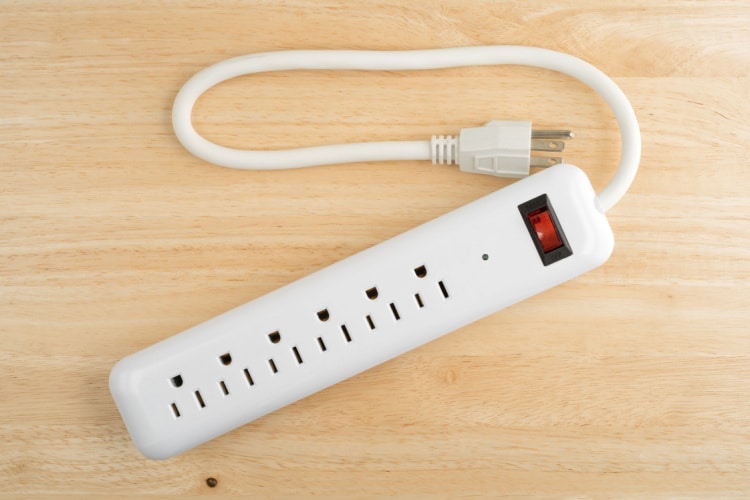Living in an area with limited access to outlets can force you to come up with creative solutions.
For instance, if you just have one outlet with two power plugs, you may have to prioritize which two devices to plug in. Or, you can take advantage of surge protectors. These handy gadgets help protect your electronics and allow you to plug more.
But what if that’s not enough, and you’re considering plugging two surge protectors into that one outlet?
Using two surge protectors in the same outlet is okay, but only if you follow strict restrictions.
Knowing the safety rules for surge protectors is crucial. An overloaded outlet increases the possibility of an electrical fire. Let’s investigate why.
Home Electricity & Electronics: Explained
Using our home electricity is a lot like cooking food — the right amount of heat gives you a delicious meal, but too much heat causes a charred mess.
Similarly, the sensitive equipment inside your home electronics needs electricity to run properly. However, too much of it will cause malfunctions, destroy it, and possibly induce a fire.
As we all know, wall outlets provide electricity for home devices. Unfortunately, these outlets are susceptible to an electrical surge, which is an abrupt increase in electrical current. The surge typically lasts a split second, but that’s enough to permanently damage the outlet and the plugged-in electronics.
Power surges often happen due to lightning strikes, electrical overload, bad wiring, and power-grid malfunctions. Because of this, many people utilize surge protectors to safeguard their technology from dangerous electrical accidents.
So how can a surge protector help?
The surge protector shunts excess voltage and sends it back to the wiring’s return line. This process may cause your circuit breaker to shut down, but it won’t harm devices plugged into the surge protector.
That being said, as we already mentioned, one of the reasons for an electrical surge is an electrical overload, which happens when you attempt to draw too much power from a single outlet.
Since surge protectors have more plugs than outlets, many people are rightfully concerned about the danger of electrical overload and a potential power surge if they put two surge protectors into a single outlet.
Let’s look at ways to neutralize this risk.
Can You Plug Two Surge Protectors into One Outlet?
Yes, you can plug two surge protectors into one outlet. But before you rush out to buy them, remember that all surge protectors have limitations.
Every surge protector is rated based on the number of joules (energy measurement) it absorbs. A standard surge protector can withstand around 1000 joules of energy, although there are more expensive choices with up to 4000 joules.
If you exceed these measurements, your surge protector will damage your plugged-in devices.
So while using two surge protectors simultaneously on the same outlet is safe, you must keep the number of plugged-in devices in each surge protector to a minimum.
For example, a few laptops or mobile phones are unlikely to use more power than your outlet can handle. But if you plug in big electricity-consuming appliances like a vacuum cleaner, microwave , air conditioner, and refrigerator into one 300-joule surge protector, you will most definitely overload it.

What Level of Joules Protection Do You Need?
Calculating the energy usage of each appliance, adding them up, and then comparing that to the energy capacity of your surge protector can be a challenging mental task. More importantly, it’s unnecessary when you have us.
To help you, we put together a table showing different joule protection levels and the household appliances that work well with each level.
| 500 — 1000 Joules Surge Protector | 1000 — 2000 Joules Surge Protector | 2000+ Joules Surge Protector |
|---|---|---|
| Charger Table lamps Digital clocks Blenders | Laptops Smart phones Smart home devices Routers Tablets Printers Copiers | HDTVs Servers Gaming consoles PC computers High-tech workstations, like those of data scientists, engineers, 3D designers, etc.) |
LED Lights on Surge Protectors
Most surge protectors include an LED light showing that the surge protection is actively safeguarding the connected equipment. If this light is off, your surge protector has reached capacity and no longer provides protection and electricity.
Surge protectors typically last three to five years and eventually lose their power protection capabilities, depending on how often power surges happen. When the surge lifespan is over and the LED light shuts off, you must buy a new surge protector.
Signs of an Overloaded Outlet
Homeowners do not always realize the actual carrying capacity of their electrical outlets. They overload them with too many devices, forgetting that the electrical outlets’ power is limited.
One reason is that we aren’t well-educated about the nature and limitations of electricity. Another is that, while professional installers recommend a solution for an electrical issue when we call them, they often skip the step of teaching us how to avoid making these mistakes in the first place.
For example, a surge protector is a wonderful alternative to power spikes and power overloads, but that shouldn’t mean we should abuse the device’s capabilities.
Your electrical outlet is probably overloaded if you notice the following signs:
- Flickering, blinking, or dimming lights
- Warm or discolored wall outlets
- Burning odor coming from wall outlets or surge protectors
- Frequently tripped circuit breaker or blown fuses
- Cracking, sizzling, or buzzing from wall outlets
- Mild shock or tingle from appliances or outlets

A Surge Protector IS NOT the Same as a Power Strip
Odds are you will find both surge protectors and power strips online or in the shop when buying electrical outlets. And since they look very similar, many people confuse them for one another.
However, a power strip is not the same as a surge protector. A power strip only provides more outlet space. In comparison, a surge protector offers more outlet space while also protecting against potential voltage spikes that might harm your gadgets, appliances, or equipment.

Power strips and surge protectors are physically similar, which is the main cause why people confuse them. Both have several outlets and an on/off switch.
Two power strips can be plugged into one outlet, but similarly to surge protectors, you need to be careful not to overload them and cause a surge.
When it comes to their appearance, surge protectors have two things that power strips don’t — LED lights and a Joule rating. So the next time you don’t know which is what, look for these signs, and you’ll be able to tell them apart easily.
Buyer’s Guide: High-Quality Surge Protectors
Now that you know you can plug two surge protectors into one outlet, you’re probably wondering which surge protectors are of high quality and will safeguard your household gadgets well.
We have seven suggestions for high-quality surge protectors you can buy online:
- JACKYLED Outlet Surge Electric Tower
- Uplift Desk Mountable Surge Protector
- Belkin Outlet
- Tripp Lite Surge Protector
Conclusion
In conclusion, it’s possible to combine power strips and surge protectors in one outlet. But, if you don’t want to overload the outlet, make sure not to plug in many things simultaneously, especially appliances that drain a lot of power, like refrigerators or microwaves.
A surge protector shields your valuable equipment from dangerous power spikes and surges. A power strip only provides more outlet space, so it’s not the same as a surge protector.
If you opt for a surge protector, always connect your equipment and the gadgets you value the most to surge protectors with high joule ratings.
Be careful, watch out for the signs of an overloaded outlet, and shop for high-quality products!